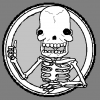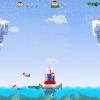Designing your game will often start in one of two ways:
1. You have an 'idea' for a new game. Write it down: what are the players doing, how do they do it, what's the challenge in the game, how does the difficulty ramp up as they play and so on.
2. You don't know what game to you want to make. Time to make some lists: games you like, games you want to write, ideas for gameplay or interface that you think might be fun or interesting. Basically, come up with as many different ideas for games of any kind that you can think of, regardless of good, bad or ugly ideas. Try for at least 20. If 20 was easy, try for 40 (you want to push yourself for the last few ideas). Then simply pick one - look back over the list and remove all the rubbish ideas, unrealistic ideas, too-similar-to-other-ideas ideas. Think about what might be catchy, fun or interesting to work on (and to play) and pick that. Congratulations, you just found your first game 'idea' :)
Once you know what sort of game you want to write you need to do 1. above. Think about as many elements of how the game will work as you can in advance:
1. What screens are you going to have? Menu, playing game, paused, finished, etc
2. What's the game control system? How will the user control the game and is that going to work for the type of game you want to make. E.g. console controllers don't seem to translate well to touchscreen, mouse based RTS games can be tricky to play using a console controller.
3. How much content will there be and how will you keep the player interested? Will you add harder levels, trickier puzzles, tougher baddies, less time, less ammo? Can you get enough into your game idea to keep a player interested? Would you want to play it?
and so on. Try and come up with as many ideas as you can. Get your friends involved and bounce ideas off them, if you can. Everyone has a different viewpoint on things, so they might spot something obvious but brilliant that you missed. Be prepared to ignore them though, this is your game and you get to make the choice about what goes in or not :)
Got lots of ideas? Great, go back to your original idea for a game and review it based on all the new ideas you've had. Come up with the core game idea that you want to create. It should be possible to express this game idea in one sentence, maybe two. Anything else and your core idea is still too vague, which will make it a lot harder to know what you need to do to create the game.
Once you've got your game concept nailed down, separate all the ideas you've had for your game into three lists:
1. The core game concept - what needs to go in to make the core concept of your game work. E.g. jumping, shooting platform game with occasional short term flight special ability that recharges, fighting baddies to save the princess on the moon.
2. Nice features - things that would be awesome to do / add but which aren't key to the core game concept. E.g. Moon buggies stages, moon golf mini-game, etc.
3. Fluff - features that might be nice but are not essential. E.g. sparkly full screen effects every time you start flying, customisable space suits, purchasable in-game hats.
Once you've got your list of features needed to support your core game concept the task list for creating your game should fall out of that.
Now start working on realising that and avoid spending any time (or at least too much time) working on list 2 or 3. They might be fun features to work on, but they won't get your game finished. Once you've got your game fully working and tested, then consider adding them.
Don't worry about knowing everything in advance though, that tends to come with experience and practice. This is your first game, do enough design so that you know what you want to be working on, but not so much that you start wasting time trying to hammer out every detail. However good your initial design, as soon as things start to get playable you'll start revising the design. E.g. Your initial weapon ideas just may not be fun, or the way the character was going to fly makes it too easy so an extended jump might be better. Always revise your design though, make sure you have something on paper describing what you're aiming to do even if you start changing things. It'll point you in the right direction when you're not sure what to do next.
A tad waffly, but I hope some of that helps get your creative juices flowing :)















